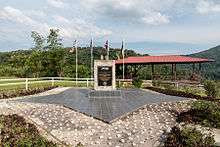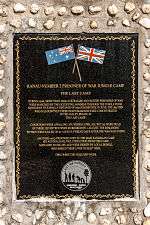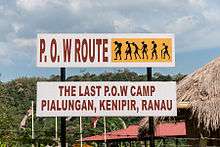Last POW Camp Memorial
| Tugu Peringatan Kem Tawanan Perang Terakhir | |
 The memorial. | |
| Coordinates | 5°54′28″N 116°38′53″E / 5.90778°N 116.64806°ECoordinates: 5°54′28″N 116°38′53″E / 5.90778°N 116.64806°E |
|---|---|
| Location | Ranau |
| Type | Stele |
| Dedicated to | Commemorates the victims of the Sandakan Death Marches who died in the camp of Ranau |
The Last POW Camp Memorial (Malay: Tugu Peringatan Kem Tawanan Perang Terakhir) is a memorial in the district of Ranau in the Malaysian state of Sabah, which commemorates the victims of the Sandakan Death Marches who died during their march to Ranau. Of 1,047 British and Australian prisoners of war, only 189 still alive to reach this site which is located near Liwagu Valley. Of these 189 total, 153 prisoners died in the next six weeks, 32 were murdered, while only four managed to escape. The current memorial was built where the former camp was located.
History

The discovery of the camp location goes back to the Australian historian, Lynette Silver. The land where the site located is a private property owned by Dr. Othman Minudin who have stated that the land should be "forever" remain as a memorial. The order also includes that the actual camp site will remain untouched by nature. The memorial stone was erected on 27 August 2009, handed over by the Minister of Tourism Datuk Masidi Manjun, by the land owner Dr. Othman and Lynette Silver as a representative of the members of the public.[1]
Description


The memorial is located about 8 kilometres south of Ranau on the road to Tambunan above the Liwagu Valley. The memorial is fenced, but is open from 9 a.m. to 5 p.m. to the public. On a large concrete surface in the shape of a star is a stele of concrete. In the concrete surface, 1,047 boulders originate from the Liwagu River (the river flows below the memorial site) been inserted. Each of these stones on the concrete surface symbolises every person who became the prisoners of war.[1]
The stele is also made of concrete. Another 183 river stones are set into the concrete of the stele; one for each prisoner of war who died in this camp on Liwagu River. On the memorial stone there are four furrowed stone slabs. It stand for the four prisoners of war, who managed to escape during the death march. On each of the four sides of the stele is a stone slab of polished granite embedded. Three panels about the history of the death marches are shown in English, Chinese and Malay. On the fourth granite slab, the names of 183 prisoners of war are perpetuated.[1]
The memorial stone in English are shown in the following inscription:
|
RANAU NUMBER 2 PRISONER OF WAR JUNGLE CAMP Conditions Were Appaling, Six Weeks Later, All But 32 Were Dead. Another 1400 Prisoners Died At the Main Sandakan Camp. They Were The Sole Survivors. |
POW route

The "Last POW Camp Memorial" is the last station of the "POW Route" during the three death marches. The route begins in Sandakan and ends at the "Last Camp" of Ranau. Every stations on the route is marked with a sign.
Literature
- Lynette Ramsay Silver: Sandakan – A Conspiracy of Silence, 4. Auflage, Sally Milner Publishing Pty, 2011, ISBN 978-1-86351-424-8
References
| Wikimedia Commons has media related to Last POW Camp Memorial. |
- 1 2 3 "Sandakan-Ranau POW Death Marches". Lynette Silver. Retrieved 12 February 2015.